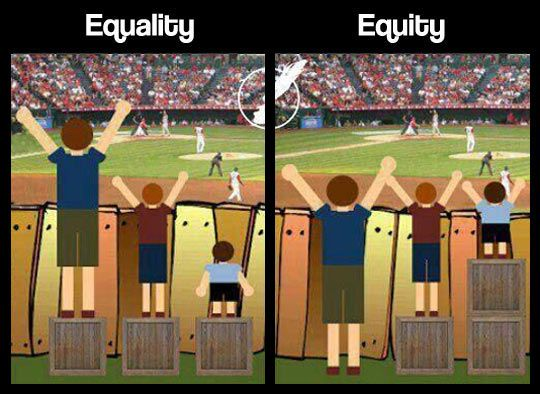Equality versus Equity Model
Equality is when everyone has the same resources, opportunities and obstacles. Equity happens when each person has what they need to achieve a desired outcome. Equal opportunity is the law, but equity is what leads to optimal outcomes of unity and productivity. The most popular representations of equity versus equality were inspired by Craig Froehle’s illustration of children looking over a fence.

Each person is given an equal share of boxes which is excessive for one and insufficient for another. I’ve had discussions with people who feel that the act of looking over the fence is wrong, and other people who say that one person should be represented by someone with a disability or on much lower ground. Each perspective is relevant to the tapestry of the discussion.
Different artists have adjusted the observers’ race, gender or age; removed the fence; and even included the police to make various points. These images of looking over a fence are an appropriate metaphor showing that equal resources only work with equal abilities, but it is incomplete and open to criticism. Here is a better analogy of both the concept of equity and the climate needed to change from equality to equity.
Inspired by a water ad from France that shows women peddling to activate an animated dancer,the following metaphor includes the missing component necessary for any discussion of equity and equality: the need
for a shared and interdependent purpose.


A shared purpose exists when everyone contributes energy to produce something that will benefit everyone; there is cooperation and collaboration. Equality, in this example, shows that everyone who is able to
ride a bike can contribute to powering the screen. Yet, the person in the wheelchair is excluded, and the goal of inclusiveness is not met nor is potential energy fully utilized.
Equity
allows everyone including those who were unable to contribute before to produce energy to power the screen. With this example it is clear that each individual contribution benefits everyone in the room. The very concept of inclusion is that everyone present has the ability to produce and engage.
Having an opportunity to contribute is a universal desire that is routinely seen across every industry. There are numerous examples of accommodations in the workplace. When wheelchair accessible ramps, large print screens, or transcription services allow people to work there is an ample supply of people wanting to participate. The rare situation however, is finding on-the-job examples where people are willing to sacrifice and give more energy to benefit others without personal gain.
Knowingly working harder without a noticeable increase in the reward feels unfair to most of us. Asking the person to run on the treadmill instead of riding the bike to power the screen is a challenging proposal. The treadmill user will be reluctant seeing that others are not working as hard.
For equity, asking those with more ability to do more is necessary. A task that does not benefit us directly requires the perspective change of working towards a shared vision and a culture of teamwork. The key to moving from equality where every person has the same equipment, to equity where everyone has the equipment that creates the most from their talents, necessitates a shared purpose and visibility of what others can achieve. We do not feel animosity towards someone who obviously does not have the same ability to contribute. However, if we judge others as capable but not as hard working, anger and jealousy can ensue. For example, we tend to attribute unacceptable weakness to a character flaw or a perceived self-inflicted condition like obesity when we don’t identify with the other person.
There is no perfect metaphor and no simple solution to creating equity, but the starting place is to have a unified purpose. When a team empathetically recognizes each member’s strengths and weaknesses, it can work together to ensure that each member maximizes their contributions.



